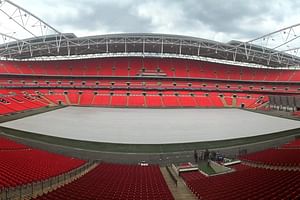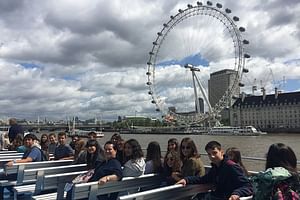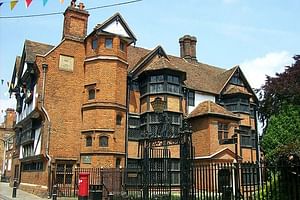-
What a brilliant Royal saga. Hampton Court Palace, also known as Hampton Court, Tudor Palace in Richmond Upon Thames, Greater London Borough. It faces the northern bank of the Thames River. In the 152...
What a brilliant Royal saga. Hampton Court Palace, also known as Hampton Court, Tudor Palace in Richmond Upon Thames, Greater London Borough. It faces the northern bank of the Thames River. In the 1520's, Cardinal Henry VIII (reigned 1509–47) gave the palace to Thomas Cardinal Wolsey, who enlarged it for his preferred residence. Throughout its large grounds trees and shrubs have been planted, and several buildings and springs have also been added. For William III (reigned 1689–1702), the garden had been redesigned in Holland; for William and his wife, Queen Mary II, architect Christopher Wren added the wing. It is a fascinating historical tour allowing you to follow the building through the ages. Indulge yourself in a Tudor fashion like Henry VIII. Let our APTG qualified blue badge tourist guides to take you on an immaculate journey throughout the timeline that starts AD 1515 up to the present.
-
Kensington Palace has been home to royalty from long before Queen Victoria's birth there in 1819 to Princess Diana's residence until her death to today. Kensington Palace is still in use as a working ...
Kensington Palace has been home to royalty from long before Queen Victoria's birth there in 1819 to Princess Diana's residence until her death to today. Kensington Palace is still in use as a working Royal Residence, there are nonetheless many areas open to public viewing - and have been since Queen Victoria opened the State Apartments to the public in 1899. The Kensington Palace Red Saloon, for example, on the Garden Floor was the location of Queen Victoria's first Privy Council in June, 1837 and has been restored to its original appearance. The Kensington Palace Royal Ceremonial Dress Collection is an exhibit of gowns worn by various royal personages from the 18th century to the present. Even the Hats and Handbags are on display at Kensington Palace, showing over seventy hats belonging to Queen Elizabeth II. In contrast to the splendour of the Kensington Palace King's Apartments, and discreetly far away, are the subdued Queen's Apartments. Built and furnished for Queen Mary II in the mid-17th century. There are several 'family portraits' and many original furnishings. The Victorian Rooms are accessible, including Victoria's bedroom where she first learned of her accession to the throne. Let our APTG qualified blue badge tourist guides take you on a journey of the timeline of the British monarchs.
-
Buckingham Palace is still the official residence of Britain's monarchy, as it has been since Queen Victoria's designation in 1837. Much of Buckingham Palace was constructed as early as 1703 for the D...
Buckingham Palace is still the official residence of Britain's monarchy, as it has been since Queen Victoria's designation in 1837. Much of Buckingham Palace was constructed as early as 1703 for the Duke of Buckingham. Buckingham House (as it was then known) was purchased in 1762 by George III, who used it as a private residence. Over the following 75 years, the house was expanded to form three wings around a central courtyard. When Queen Victoria discovered Buckingham Palace lacked several 'necessary' rooms - such as a formal ballroom, a nursery, visitor's bedrooms and others - major additions were undertaken, including adding an entire wing to form a quadrangle. The Marble Arch was moved to Hyde Park, where it still resides near Speaker's Corner. With the re-facing using Portland stone in 1913, the palace received its last major change. Buckingham Palace is still actively used as both residence and offices, over 50,000 guests and invited diplomats to visit per year who interact with over 400 individuals for whom this is 'the office'. Nevertheless, several parts of Buckingham Palace are open to the public.
-
Located right in the middle of London's iconic landmarks such as Houses of Parliament, Elizabeth Tower (a.k.a Big Ben), Whitehall, Saint-Margaret's Church, Westminster Abbey and Westminster Bridge. Pa...
Located right in the middle of London's iconic landmarks such as Houses of Parliament, Elizabeth Tower (a.k.a Big Ben), Whitehall, Saint-Margaret's Church, Westminster Abbey and Westminster Bridge. Parliament Square houses eleven state figures and world leaders, including Sir Winston Churchill, Gandhi and Nelson Mandela. Parliament Square in London is a popular destination among tourists. The atmosphere is magnificent and it's one of the must-visit locations in the city.
-
Westminster Abbey is a Church, burial ground, coronation site and much more and continues to attract visitors over 900 years after its founding. In many respects the architecture is common. There's th...
Westminster Abbey is a Church, burial ground, coronation site and much more and continues to attract visitors over 900 years after its founding. In many respects the architecture is common. There's the traditional cross-shaped floor plan with a nave, north and south transepts and several round side areas but both its execution and use raise The Collegiate Church of St Peter, Westminster (the official name) to among the highest examples of church construction. Here at Westminster Abbey lie buried kings and poets, scientists and philosophers who have themselves raised humankind to the highest levels. Isaac Newton and James Clerk Maxwell (discoverer of electromagnetic theory, which later leads to radio and TV), Chaucer and Kipling, Dr Samuel Johnson (creator of the first English dictionary) and many other justly famous names are interred here.
-
The Houses of Parliament, known also as the Palace of Westminster is where the two Houses of the Parliament of the United Kingdom (the House of Lords and the House of Commons) conduct their sittings. ...
The Houses of Parliament, known also as the Palace of Westminster is where the two Houses of the Parliament of the United Kingdom (the House of Lords and the House of Commons) conduct their sittings. They lie on the north bank of the River Thames in the London borough of the City of Westminster, close by other government buildings in Whitehall. The oldest part of the building is still in existence, Westminster Hall, which dates from 1097. The palace originally served as a royal residence, but no monarch has lived in it since the 16th century. Most of the present Houses of Parliament structure dates from the 19th century when the Palace was rebuilt after it was almost entirely destroyed by a fire in 1834. The architects responsible for rebuilding the Palace was Sir Charles Barry and Augustus Welby Pugin, and the building is an example of the Gothic revival.
-
London Bridge is a bridge over the River Thames, between the City of London and Southwark. It is between Cannon Street Railway Bridge and Tower Bridge; it also forms the western end of the Pool of Lon...
London Bridge is a bridge over the River Thames, between the City of London and Southwark. It is between Cannon Street Railway Bridge and Tower Bridge; it also forms the western end of the Pool of London. The original London Bridge made this one of the most famous bridge emplacements in the world. It was the only bridge over the Thames in London until Westminster Bridge was opened in 1750. A bridge has existed at or near the present site for nearly 2000 years. The first bridge across the Thames in the London area was built by the Romans on the present site around 76 AD and was made of wood. The location was most likely chosen as a bridgeable spot which still had deepwater access to the sea. The bridge fell into disrepair after the Romans left in 410 AD, but at some point either it was repaired or a new timber replacement constructed, probably more than once. In 1013, the bridge was burned down by King Ethelred in a bid to divide the invading forces of the Dane Svein Haraldsson. This episode reputedly inspired the well-known nursery rhyme London Bridge is falling down. The rebuilt London Bridge was destroyed by a storm in 1091 and yet again, this time by fire, in 1136. he current London Bridge was constructed by contractors John Mowlem from 1967 to 1972 and opened by Queen Elizabeth II on March 17, 1973. London Bridge is a fairly dull edifice comprising three spans of pre-stressed concrete cantilevers, paid for in part by the sale of the earlier Rennie bridge. It is 928 feet (283 metres) long. The cost of £4m was met entirely by the City of London's Bridge House Estates. The current bridge was built in the same location as Rennie's bridge, which was carefully demolished piece by piece as the new bridge was built, so the bridge would remain in use throughout. Time to solve the big mix up between Tower Bridge and London Bridge. Carefully listen to the story of London Bridge from Tourope UK's APTG qualified blue badge tourist guides.
-
Few prisons can claim to be as popular as the Tower of London, an attraction - unpleasant for some - for over 900 years. Its twenty towers are filled with an ancient tradition of royal blood, armor an...
Few prisons can claim to be as popular as the Tower of London, an attraction - unpleasant for some - for over 900 years. Its twenty towers are filled with an ancient tradition of royal blood, armor and jewels and the history to match.
The Tower of London central structure began as a fort - used by the original builder William the Conqueror who completed the first tower around 1100 AD. At its completion it was the tallest building in London. Henry III had it whitewashed in the 13th century and the name, White Tower, has stuck.
Later it evolved into a prison, used by Henry VII (and many others). Still later - and continuing to this day - it has acted as a repository for the extensive collection of crown jewels. Henry VII, nearly always short of money, had few jewels to store.
But the stone complex, near the Tower Bridge alongside the River Thames, has also been used at various times to house the Royal Mint, the Public Records, the Royal Menagerie (later to form the starting point of the London Zoo) and an observatory (built in 1675). Listen to the rest of the story of the Tower of London from us today.
-
Tower Bridge is probably the city's most distinctive symbol of today. The Bridge shows a lot to its medieval predecessor London Bridge with its starlings and elaborate twin towers that give the bridge...
Tower Bridge is probably the city's most distinctive symbol of today. The Bridge shows a lot to its medieval predecessor London Bridge with its starlings and elaborate twin towers that give the bridge its name but it's not just a homage to the past, hidden inside that medieval-looking exterior there's a rather wonderful piece of Victorian engineering and in its day it was the biggest and most sophisticated lifting bridge in the world. Unlike London Bridge, the genius of the design is that the bridge can act as a gateway swinging open to allow tall ships to pass through. We will tell you plenty of things about this masterpiece in London, just follow us!
































































